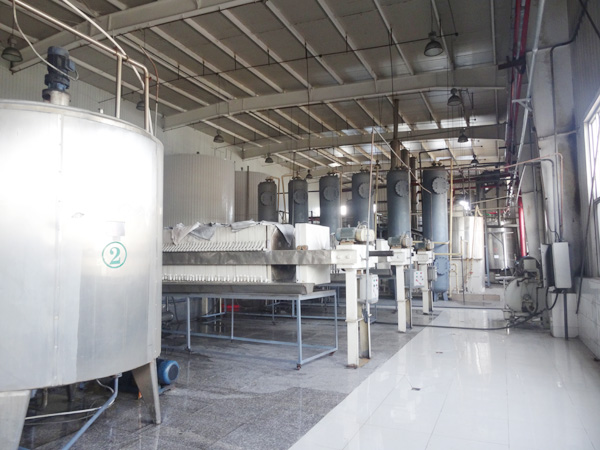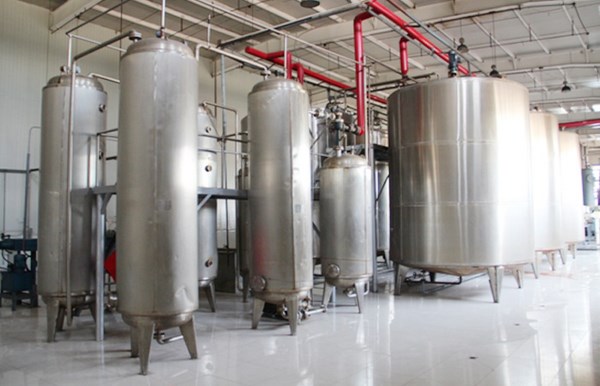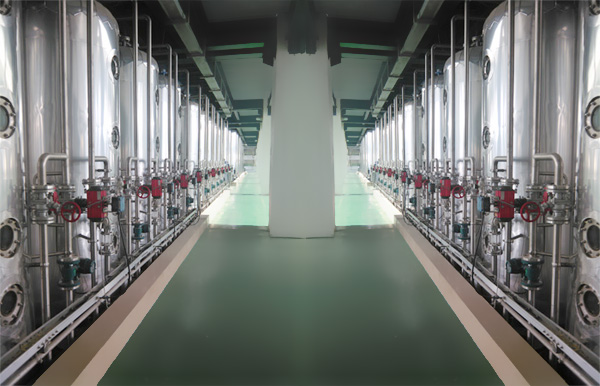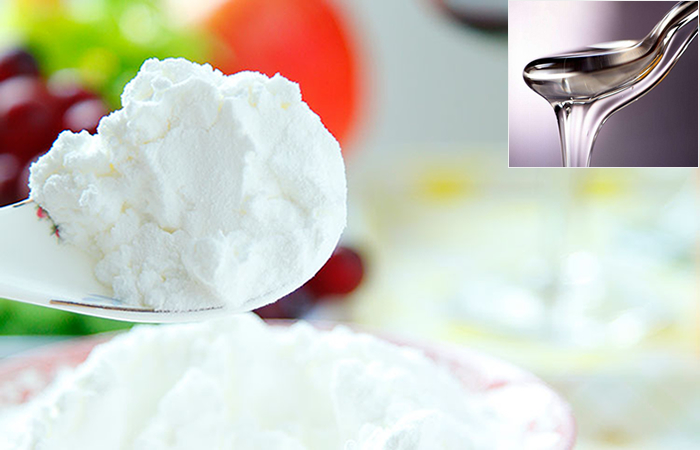Enzymatic production of high fructose corn syrup
2018-10-08 / FAQ
The commercial production of high fructose syrup relies on the multienzymatic hydrolysis of starch based on three enzymes namely α-amylase, amyloglucosidase and glucose isomerase. The first two enzymes hydrolyze starch into glucose and third enzyme i.e., glucose isomerase catalyzes the isomerization of glucose into fructose. The yield of fructose obtained by this method is not more than 45%. To increase the fructose content over 90%, ion-exchange techniques have been developed, which add to he cost of the enzymatic production of high fructose corn syrup. Briefly, the steps involved in the conventional production of high fructose syrup from starch are described on next.

High fructose corn syrup production plant
1. Starch Liquefaction:
Typical industrial starch liquefaction processes for the enzymatic production of high fructose corn syrup namely, Enzyme-Heat-Enzyme (EHE), High Temperature (HT) and Low Temperature (LT). The low DE hydrolysate produced by enzymatic liquefaction is used as substrate for the production of corn sweeteners or processed to a dry or liquid maltodextrin products.
Enzymatic liquefaction or partial hydrolysis of starch yields a soluble, low viscosity substrate with low dextrose equivalent (DE), for subsequent conversion to a variety of products. Degree of hydrolysis is often expressed in terms of dextrose equivalents (DE). DE is de?ned as the percentage of reducing sugars present, calculated as dextrose (D-glucose) on a dry solids basis.

Liquefaction tank
2. Conversion of Starch Hydrolysate to Dextrose:
Fungal glucoamylases from Aspergillus or Rhizopus sp are used to convert liquefied starch to a dextrose-containing hydrolysate, by cleaving α-1.4- and α-1.6 glucosidic linkages for enzymatic production of high fructose corn syrup. Glucoamylase acts sequentially from the non-reducing end of the molecule. A glucoamylase dosage is added to produce a maximum dextrose level in 1-4 days. Reaction time is inversely related to dose, so if a given dose yields maximum dextrose in 4 days, doubling or quadrupling the dose will reduce reaction time to 2 days or 1 day.
For another, overdosing with glucoamylase or extending reaction time beyond the maximum dextrose level will result in decrease in dextrose yield because of continued formation of maltose and isomaltose. Maximum dextrose level can be increased by operation at lower solids, since the reverse reaction is less favored as water concentration is increased. Proper pH during liquefaction has to be maintained for lower maltulose levels. This part is important for enzymatic production of high fructose corn syrup.

Isomerisn
3. Isomerization of Dextrose to Fructose:
Immobilized glucose isomerase is used to convert refined 93-96% dextrose hydrolysate to a 42% fructose product in the process of enzymatic production of high fructose corn syrup. Commercially available enzymes and their recommended operating conditions. Several parameters like feed purity, solids, temperature, pH, oxygen level, magnesium content and reaction time, are carefully controlled to optimize product yield. These parameters also ensure adequate operational stability of the enzyme reactor.
Flow rate through the column is another important parameter to control the fructose yield for enzymatic production of high fructose corn syrup. The 42% fructose product containing 51-54% dextrose is refined by carbon and ion-exchange treatments to remove color, off-favors, salts and other impurities, and fnally concentrated to 71% solids. Storage temperature of 27-32oC is recommended to prevent dextrose crystallization. Products containing higher fructose levels are manufactured by combining chromatographic techniques with blending. The refined 42% HFS is passed through cationic adsorbent containing calcium groups, where fructose is retained and non-fructose saccharides pass through the column. These wash-out saccharides can be re-fed for isomerization. The high fructose fraction can be eluted with water and generally contains 80-90% fructose with 7-19% dextrose.
To sum up, this is the enzymatic production of high fructose corn syrup technology process brief description. DOING company professional in high fructose corn syrup production plant design and installation, offer the technology data for the enzymatic production of high fructose corn syrup.

High fructose corn syrup production plant
Typical industrial starch liquefaction processes for the enzymatic production of high fructose corn syrup namely, Enzyme-Heat-Enzyme (EHE), High Temperature (HT) and Low Temperature (LT). The low DE hydrolysate produced by enzymatic liquefaction is used as substrate for the production of corn sweeteners or processed to a dry or liquid maltodextrin products.
Enzymatic liquefaction or partial hydrolysis of starch yields a soluble, low viscosity substrate with low dextrose equivalent (DE), for subsequent conversion to a variety of products. Degree of hydrolysis is often expressed in terms of dextrose equivalents (DE). DE is de?ned as the percentage of reducing sugars present, calculated as dextrose (D-glucose) on a dry solids basis.

Liquefaction tank
Fungal glucoamylases from Aspergillus or Rhizopus sp are used to convert liquefied starch to a dextrose-containing hydrolysate, by cleaving α-1.4- and α-1.6 glucosidic linkages for enzymatic production of high fructose corn syrup. Glucoamylase acts sequentially from the non-reducing end of the molecule. A glucoamylase dosage is added to produce a maximum dextrose level in 1-4 days. Reaction time is inversely related to dose, so if a given dose yields maximum dextrose in 4 days, doubling or quadrupling the dose will reduce reaction time to 2 days or 1 day.
For another, overdosing with glucoamylase or extending reaction time beyond the maximum dextrose level will result in decrease in dextrose yield because of continued formation of maltose and isomaltose. Maximum dextrose level can be increased by operation at lower solids, since the reverse reaction is less favored as water concentration is increased. Proper pH during liquefaction has to be maintained for lower maltulose levels. This part is important for enzymatic production of high fructose corn syrup.

Isomerisn
Immobilized glucose isomerase is used to convert refined 93-96% dextrose hydrolysate to a 42% fructose product in the process of enzymatic production of high fructose corn syrup. Commercially available enzymes and their recommended operating conditions. Several parameters like feed purity, solids, temperature, pH, oxygen level, magnesium content and reaction time, are carefully controlled to optimize product yield. These parameters also ensure adequate operational stability of the enzyme reactor.
Flow rate through the column is another important parameter to control the fructose yield for enzymatic production of high fructose corn syrup. The 42% fructose product containing 51-54% dextrose is refined by carbon and ion-exchange treatments to remove color, off-favors, salts and other impurities, and fnally concentrated to 71% solids. Storage temperature of 27-32oC is recommended to prevent dextrose crystallization. Products containing higher fructose levels are manufactured by combining chromatographic techniques with blending. The refined 42% HFS is passed through cationic adsorbent containing calcium groups, where fructose is retained and non-fructose saccharides pass through the column. These wash-out saccharides can be re-fed for isomerization. The high fructose fraction can be eluted with water and generally contains 80-90% fructose with 7-19% dextrose.
To sum up, this is the enzymatic production of high fructose corn syrup technology process brief description. DOING company professional in high fructose corn syrup production plant design and installation, offer the technology data for the enzymatic production of high fructose corn syrup.





